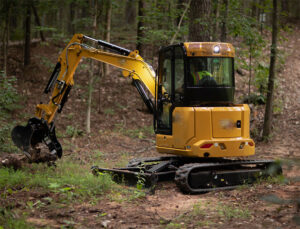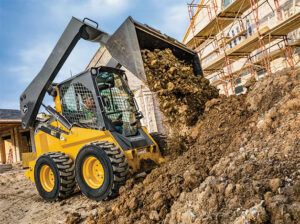I. Basic operating skills (must be learnt by novices)
Starting and checking
Pre-start inspection: check whether the fluid (oil, hydraulic oil), tyre pressure, braking system, lights and instruments are normal, and make sure there is no residue in the bucket.
Cold start warm-up: idle for 3-5 minutes after starting in winter, wait for the water temperature to rise to 50℃ before starting the operation to avoid engine wear.
Essentials of smooth operation
Starting: hang the low gear (Ⅰ gear) and release the clutch slowly to avoid rapid acceleration leading to tyre slippage or material spillage.
Steering: slow down in advance when steering, avoid turning sharply at high speed (especially when fully loaded) to prevent rollover.
Shifting skills: choose gears according to the load, use low-speed gears (such as Ⅱ gears) for heavy loads, and use high-speed gears (Ⅲ gears) for empty loads.
Tips for loading materials
Cutting angle: the bottom of the bucket is parallel to the ground, and insert into the pile of materials at an angle of 10-15° to avoid damage to the shovel blade by ‘hard dislike’.
Lifting with full load: When the bucket is full, collect the bucket first and then lift the arm to reduce material spillage.
Accuracy of unloading: control the height of the arm when unloading, keep the distance between the bucket and the truck compartment 30-50cm, and turn the bucket slowly to avoid smashing the truck.
Second, advanced operation skills (improve efficiency and safety)
Complex terrain response
Slope operation: keep the front end of the truck facing upward/downward direction when going up or down the slope, and forbid driving horizontally; someone should direct the truck when the slope is more than 15°.
Muddy road: lower tyre pressure (increase grounding area), use differential lock to prevent one-sided skidding.
Refinement operations
Levelling the ground: use the bottom of the bucket to drag the ground in the reverse direction (‘scraping method’), with the fine-tuning of the hydraulic handle to control the precision.
Narrow space operation: Use the ‘Crab Mode’ (supported by some models) to allow the front and rear wheels to steer in the opposite direction to reduce the turning radius.
Combined operation
Load + transport linkage: When working with trucks, adopt the ‘V-shaped route’ or ‘shuttle method’ to reduce idling time.
Multi-machine co-operation: When working with other machines (e.g. excavators) at large construction sites, keep a safe distance and communicate with light signals.
Third, the safety operation norms (to avoid accidents)
Personnel safety
It is forbidden to stand people within 5 metres radius of operation, especially forbidden to stay under the bucket.
When reversing, you need to sound the horn and observe the rear-view mirror, and be guided by the conductor if necessary.
Equipment protection
Avoid prolonged overloading (e.g. loading ore with a density >2.5t/m³) to prevent overheating of the hydraulic system.
It is forbidden to ‘hit’ hard objects (e.g. frozen soil, boulders) with the bucket to avoid damaging the structural parts.
Emergency treatment
In case of sudden breakdown: switch off the engine immediately, put it into neutral and tighten the handbrake, and place a warning sign.
Lateral tilt risk: If the body tilts, quickly lower the bucket to the ground to support the balance.
Fourth, maintenance skills (to extend the life of the equipment)
Daily maintenance: clean the radiator dust, check the hydraulic pipe for oil leakage, lubricate the bucket pin.
Weekly focus: replace the air filter (dusty environment needs to shorten the cycle), tighten the tyre bolts.
Long-term parking: drop the bucket to the ground, release the pressure of the hydraulic system, and disconnect the battery.

Optimisation of forklift aftermarket parts supply
With the continuous expansion of forklift applications, the demand for forklift parts in different industries and different usage scenarios presents the characteristics of diversity and complexity. Cu





